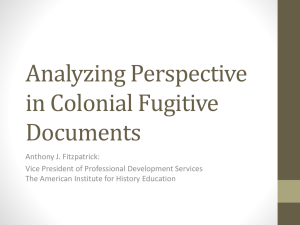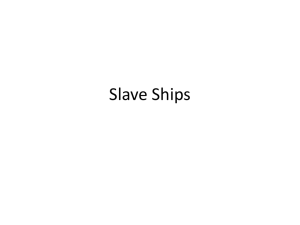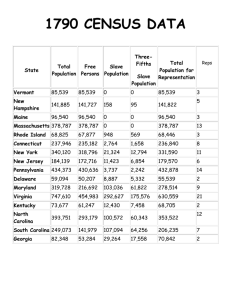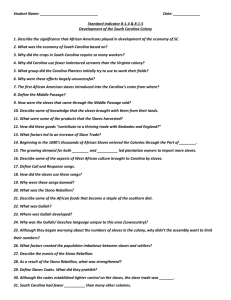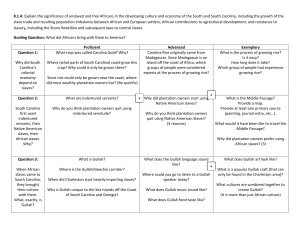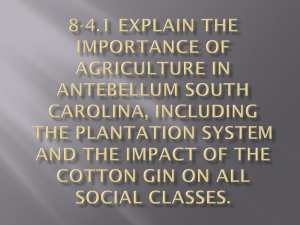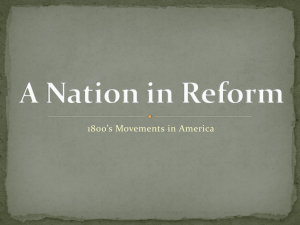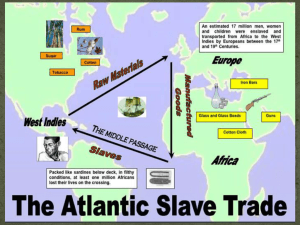Runaway Slave PowerPoint
advertisement
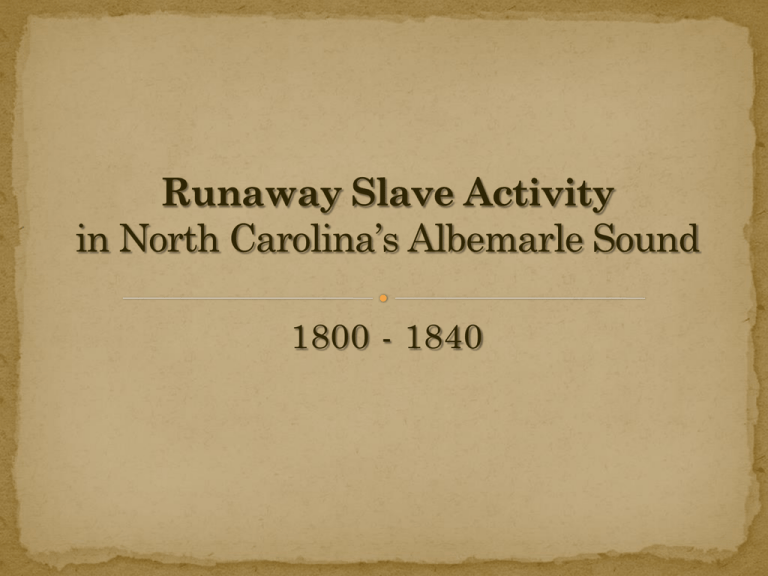
1800 - 1840 If you had lost expensive property, what types of information would you consider important to assure its return? Slave owners followed a fairly standardized format for describing their run-away property. Advertisements provide a wealth of information regarding descriptions, activities and possible destinations for runaway slaves. They had a physical description consisting of such aspects as: complexions, height, body shape, scars and brands, dental condition, hair, age and any characteristic that might bring attention. They also alluded to possible directions which might be followed and family locations. They listed skills and talents which might aide in their slaves escape. William Henry Singleton, former slave on the Neuse River Historical Maps exist that show the waterways and wetlands for us to understand the landscape for runaway destinations. It is unclear if maps were available for runaway attempts. From the newspaper advertisements , it is clear that a network of destinations existed and the following information was probably known. Waterways and wetlands provided networks for runaways. The slave owners were aware of these networks. The runaways were aware of the exact locations of these networks . Slaves who were boatmen, navigators, stevedores, and fishermen knew about the waterway and wetland networks. Slaves had knowledge, guides or maps for these runaway networks. J.H. COLTON 1856 MAP Tanner, Henry Schenck, 1786-1858 Current Satellite Digital Image Historical maps allow us to understand locations and landscapes described in the advertisements. These are known as primary sources. Can you list other means of obtaining historical knowledge that comes as close to the original source as possible? Every time you make a note or write a letter; if you keep a diary or take a photograph you are recording history and creating a primary source for people of the future. From these someone may learn what life was like for you. Can you pinpoint the runaways’ movements on a map? Try drawing a picture of what they might have looked like using characteristics provided in the ads Research the habitation areas of indigenous peoples, and others such as the Quakers, who were sympathetic to the conditions of slavery. Construct an itinerary or plan of where you would go as a runaway. What would you take with you, and how would you decide what to leave behind? Justify your plans and decisions. Stephen a slim spare made fellow, thick bushy head of hair, remarkable small legs, rather of a yellowish complexion, and about 4 feet 9 or 10 inches high, the fore finger of his left hand in entirely stiff, occasioned by a bite in the joint when fighting. He is remarkable fond of fidling, and commonly has a fiddle hung to his back. He has a mother living in the County of Pasquotank by the name of Franky. I have lately been informed that a fellow of that name and description has been seen working in the Shingle Swamp, and flatting shingles down the Canal. James Wood, sen. Hertford A dark Mulatto Man, about thirty-seven years of age, five feet seven inches high, and very stout made He is very artful, and professes to be a Cooper and Job Carpenter He formerly belonged to Mr. James Blount, of Washington County, and came to this County as a Freeman He can write He is well acquainted along the Sea-Coast from their to the Virginia line – and may lurk about Wilmington, Newbern, Edenton, or Beaufort Or may endeavor to get on board some vessel by calling himself a free-man John C. Baker, Brunswick Co., 1808 Is about 5 feet 3 inches high, very black, about 24 years of age He has a very notable scar over his right eye, occasioned by the kick of a horse when he was young A tailor by trade, and can beat the drum extremely well Was born in the Island of Guadaloupe, to which place he has lately threatened to go He speaks French pretty well and is a very artful insinuating fellow, particularly when in liquor I have reason to believe, he will make for--- Elizabeth-city or Norfolk, for the purpose of effecting his escape either toward Northwards or the West-Indies Joseph Manning, Edenton, Oct.14, 1811 Maps give a good depiction of how slaves could slip away and hide in this watershed landscape. What would be an important skill to have living in an area bounded by rivers, streams and the Great Dismal Swamp? Most coastal slaves spent at least a part of their time working on the water as pilots and boatmen they rafted timber and supplies to market and became experts at navigating through the ever changing waterways Many became fisherman and stevedores while others worked as shipbuilders, caulkers, sail makers, cord swains, and became indispensable as nautical trades men. “The Lightkeeper’s Boat” by Edward Champney - Courtesy Outer Banks History Center, Manteo, NC This fear lead to legislation being passed which strictly regulated and administered penalties on those who might provide a haven, and captains that could give them passage north Stern warnings were given to “All masters of vessels and others from harboring, employing, or carrying off, under the penalty of the law” No mention was made of their maritime culture or credit given for their adept seamanship This access to the sea, not only afforded them a freedom unheard of on the plantation, it gave them hope by providing contacts and information with a world out side their own, and eventually for some, networks to freedom. “overrun with fugitives from the surrounding towns and plantations…,” as thousands of African Americans f led bondage, “It would be utterly impossible…to keep them outside of our lines…, as they find their way to us through woods and swamps from every side.” General Ambrose B. Burnside Begin a story relating to a particular advertisement then pass it to another who adds more to the story line, so on and so on. Think about what it would be like to live as a slave. How would it be to own slaves, what type of master would you be? How would you treat them and what would you allow them to do? Would you separate families? Create a Journal •For a runaway slave •Describe their experiences. •Include how they would survive, who could they talk to, what would they take or eat Research an authentic slave diary OR a diary you write as a joint class project. Depict their lives and conditions. It could be set up as flash-backs, or an oral history being told from the orchestra, with scenes fading in and out of the background as the story is told. Think about what skills they may have brought with them and what activities they may have learned from others. How would information travel and what connections and interactions would need to take place? What would Stephen, Frank or Quacko look like? If you met one of them today what would ask them? Do you think you would like them? Give your reasons why or why not. What might you tell them about yourself? Cecelski, David S., The Waterman’s Song, University of North Carolina Press, Chapel Hill and London 2001: slide4:p59, slide9:p25, slide19:pxiii,p20, slide20:p18, slide21:p13, slide23:p181, slide24:p167 Cumming, William P., North Carolina in Maps, North Carolina Department of Cultural Resources, Raleigh 2001 Geology.com, North Carolina County Map, 2005-2010, slide8 http://geology.com/county-map/north-carolina.shtml Google Images, Slave Advertisements, slides3-4, http://www.google.com/images Google Earth Maps, North Carolina, 2010 Europe Technologies, Image USDA Farm Service Agency, 2010 Google, slide7 NC Department of Public Instruction Middle Grades Division, North Carolina Standard Course of Study, Discover NC: Examining the Development of the State through the Coastal Plain, slide25 http://www.dpi.state.nc.us/curriculum/socialstudies/middlegrades/discovernc/, North Carolina Maps, Interactive, Entire State, http://www.lib.unc.edu/dc/ncmaps/about.html , slides6,7,12,14,16-18 Parker, Freddie L., Running for Freedom, Garland Publishing, Inc., New York & London 1993, slide17:p , slide18:p33, slide22:p29 Parker, Freddie L. ed., Stealing a Little Freedom, Garland Publishing, Inc., New York & London 1994, slide 2:p , slide11-16:p344,353,856
